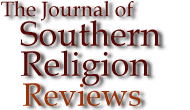

Barry Hankins, Uneasy in Babylon: Southern Baptist Conservatives in American Culture, Tuscaloosa, AL: University of Alabama Press, 2002. 344 pages. Reviewed by Justin Watson, Le Moyne College, for the Journal of Southern Religion.
| "Hankins is going against the common notion that SBC conservatives are reasserting the southernness (read racism, patriarchy, and general backwardness) of the SBC." | |
Hankinsís title, Uneasy in Babylon, is a play upon Rufus Spain's At Ease in Zion (1967) which depicted the close relationship between Southern Baptists and southern culture in the late nineteenth and early twentieth centuries. By the late twentieth century, however, SBC conservatives perceived that this southern Zion was long gone and America had become Babylon, a secular culture hostile to faith. SBC conservatives elected to actively resist this culture and decided to begin by ousting those SBC moderate leaders who seemed too much at ease in Babylon. In other words, Hankins tells us that the conflict between SBC conservatives and moderates was based on contrasting perceptions of American culture.
Hankins is going against the common notion that SBC conservatives are reasserting the southernness (read racism, patriarchy, and general backwardness) of the SBC. By examining the development and thinking of specific conservative leaders, such as Albert Mohler, Richard Land, and Adrian Rodgers, Hankins is able to demonstrate that important influences upon them were neither southern nor Baptist, but more broadly national and evangelical. In particular, the thinking of evangelicals Carl F.H. Henry and Francis Schaeffer provided SBC conservatives with a perception and analysis of American culture that has motivated and guided their movement. Rather than a reassertion of a traditional regional culture, the SBC conservative movement represents the nationalization of SBC identity and a continuing engagement with American culture, albeit usually in dissent.
Hankins outlines the conservative outlook and its basic coherence in his initial chapters. The remainder of the book demonstrates how this outlook has operated in specific circumstances, such as at Southern Seminary in Louisville, or in the context of specific issues, such as church-state, abortion, and the role of women. Hankins devotes an interesting final chapter to SBC conservatives and race. "For conservatives," Hankins observes, "race is the one topic where progressives were right." (243) This stance is reflected in the 1995 convention's resolution on racial reconciliation and continuing efforts to increase African American SBC membership. "The question for conservatives then was not whether they would revert to such racism," writes Hankins, "but whether race would become a priority for them." (243)
Most of my difficulties with this book are a specialist's quibbles over details that I will not mention here. I was disappointed, however, that the SBC's Disney boycott—fine example of cultural dissent that could have easily been the subject of a chapter—was mentioned in passing just once. A more serious difficulty is that as Hankins discusses specific issues we hear less and less from leaders, such as Adrian Rodgers, who articulate the conservative outlook in what Hankins calls a "populist" mode. This less nuanced and less coherent version of what the SBC conservative rank-and-file more often hear and read almost disappears in the later chapters. A more consistent inclusion of the populist version of the conservative message would have been helpful.
Beyond the usefulness of Uneasy in Babylon in understanding SBC conservatives, Hankins provides a sound model for the study of controversial movements, movements that inspire strong feelings about important issues. While Hankins identifies himself as someone who generally sympathizes with SBC moderates and travels in moderate circles, he tells us, "I can only say that my goal in this book is to understand and explain the conservatives and not to refute them." (12) He hears his subject out but he seldom lets them get away with anything. Rather than sounding an alarm against the advancing barbarians, Hankins's attempt to understand and explain, not refute, is meant to move the scholarly discussion, not a partisan or ecclesiastical agenda, forward.
Justin Watson, Le Moyne College
© 1998-2003 by The Journal of Southern Religion. All rights reserved. ISSN 1094-5234